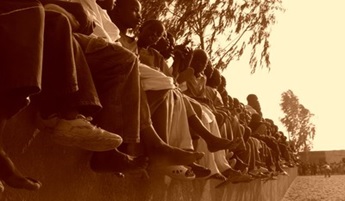 Goma is the capital of the North Kivu region of the Democratic Republic of Congo, a country half the size of the US which spans the African continent from west to east. In many respects, it is the capital of the DRC in the minds of Western consciousness. The events that register Congo internationally take place almost exclusively within a small section hugging the border with Rwanda in a province to which Goma is the seat. It was here that tens of thousands of refugees per hour fled across the border from Rwanda during the 1994 genocide.
Goma is the capital of the North Kivu region of the Democratic Republic of Congo, a country half the size of the US which spans the African continent from west to east. In many respects, it is the capital of the DRC in the minds of Western consciousness. The events that register Congo internationally take place almost exclusively within a small section hugging the border with Rwanda in a province to which Goma is the seat. It was here that tens of thousands of refugees per hour fled across the border from Rwanda during the 1994 genocide.
The town has also served as a camp for internally-displaced Congolese, who fled the nihilistic rebel violence afflicting the surrounding hills and as a staging ground for Laurent Kabila’s army, which overthrew the regime of Mobutu Sese Seiko, the country’s longtime ruler. Indeed, it is easy to measure Goma’s importance by the number of SUVs for the UN and foreign aid organizations that one sees about town. They constitute not a majority, but the near totality of vehicles which are found on Goma’s reasonably-trafficked streets.
Goma’s more recent afflictions include a rebel invasion and the eruption of a massive volcano which destroyed nearly half the town. If one did not know its history, though, one would merely be struck by Goma’s rich silver-black soil and its abundance of upscale hotels and large villas. Besides this, Goma is normal Africa.
If it were possible to travel freely, the DRC would be an ideal country for Best Grade, given the level of technology and the structure of education. The level and quality of both is on par with Senegal circa 2005; PIII computers and a few better, used principally for administrative work and some teaching; school authorities with large administrative burdens and a loose central regulatory authority over education. It is so loose, in fact, that the central government barely even pays salaries to the Academic Inspectors. Since this is the case they pay their bills by selling official administrative forms to schools at high prices and requiring their purchase.
In short, even in one of the worst countries on Eath, there is potential for and utility in introducing management software. At the very least, it would have prevented the total loss of student information from damage from the 2003 volcanic eruption. Better yet, it will allow schools to trim a half dozen administrators and instead fund more teachers or other necessities. However, there’s litle doubt that education management is not high on the ngos/governments priority list, though, given the raging war, refugee problem, volcano, instability, corruption, and other issues which take precedence. Individual schools would stand to benefit from the software and would conceivably pay for it. There is, however, a question of market size in a country where the average teacher salary is 50 dollars a month.
Sadly, the education system functions and is more organized in Goma than in many parts of Senegal. As in most parts of east Africa, the majority of schools are private. As a principal noted, even the state schools are private, since the government hardly provides any financing anymore. Within this context, there is the continual opportunity for improvement, reform, and seeking out cost savings, since schools must budget for themselves and conserve and compete for financial resources.
 Project Best Grade
Project Best Grade